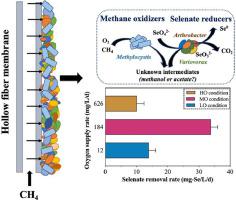Water Research ( IF 11.4 ) Pub Date : 2021-04-14 , DOI: 10.1016/j.watres.2021.117150 Yulu Wang , Chunyu Lai , Mengxiong Wu , Yarong Song , Shihu Hu , Zhiguo Yuan , Jianhua Guo

|
Although methane (CH4) has been proven to be able to serve as an electron donor for bio-reducing various oxidized contaminants (e.g., selenate (SeO42−)), little is known regarding the roles of oxygen in methane-based reduction processes. Here, a methane-based membrane biofilm reactor (MBfR) was established for evaluating the effects of oxygen supply rates on selenate reduction performance and microbial communities. The oxygen supply rate played a dual role (stimulatory or suppressive effect) in selenate reduction rates, depending on the presence or absence of dissolved oxygen (DO). Specifically, selenate reduction rate was substantially enhanced when an appropriate oxygen rate (e.g., 12 to 184 mg/L.d in this study) was supplied but with negligible DO. The highest selenate reduction rate (up to 34 mg-Se/L.d) was obtained under an oxygen supply rate of 184 mg/L.d. In contrast, excessive oxygen supply rate (626 mg/L.d) would significantly suppress selenate reduction rate under DO level of 3 mg/L. Accordingly, though the high oxygen supply rate (626 mg/L.d) would promote the expression of pmoA (5.9 109 copies g−1), the expression level of narG (a recognized gene to mediate selenate reduction) would be significantly downregulated (6.1 109 copies g−1), thus suppressing selenate reduction. In contrast, the expression of narG gene significantly increased to 2.8 1010 copies g−1, and the expression of pmoA gene could still maintain at 1.1 109 copies g−1 under an oxygen supply rate of 184 mg/L.d. High-throughput sequencing targeting 16S rRNA gene, pmoA, and narG collectively suggested Methylocystis acts as the major aerobic methanotroph, in synergy with Arthrobacter and Variovorax which likely jointly reduce selenate to selenite (SeO32−), and further to elemental selenium (Se0). Methylocystis was predominant in the biofilm regardless of variations of oxygen supply rates, while Arthrobacter and Variovorax were sensitive to oxygen fluctuation. These findings provide insights into the effects of oxygen on methane-dependent selenate reduction and suggest that it is feasible to achieve a higher selenate removal by regulating oxygen supply rates.
中文翻译:

氧在膜生物膜反应器中甲烷依赖性硒酸盐还原中的作用:刺激或抑制
尽管已证明甲烷(CH 4)可以用作生物还原各种氧化污染物(例如硒酸盐(SeO 4 2-))的电子供体,但对于氧在基于甲烷的还原中的作用知之甚少流程。在这里,建立了一个基于甲烷的膜生物膜反应器(MBfR),用于评估氧气供应速率对硒酸盐还原性能和微生物群落的影响。供氧速率在硒酸盐还原速率中起着双重作用(刺激或抑制作用),具体取决于溶解氧(DO)的存在与否。具体地,当适当的氧气速率(例如12至184mg / L)时,硒酸盐的还原速率显着提高。本研究中的d)已提供,但DO可以忽略不计。最高硒酸还原率(高达34毫克硒/ L 。的184毫克/升的氧气供给速度下获得d) 。d。与此相反,过剩的氧供给量(626毫克/升。 d)将下的3 mg / L的DO水平显著抑制硒酸还原率。因此,虽然高氧气供给速度(626毫克/升。 d)将促进的表达pmoA(5.910 9个拷贝g -1),narG(介导硒酸还原的公认基因)的表达水平将显着下调(6.110 9份g -1),因此抑制了硒酸盐的还原。相反,narG基因的表达显着增加至2.810 10拷贝g -1,pmoA基因的表达仍可维持在1.1在184 mg / L的氧气供应速率下10 9份g -1 。d。高通量测序靶向16S rRNA基因,pmoA,和narG共同建议Methylocystis充当主要需氧甲烷营养,在具有协同节和贪噬菌这可能共同降低到硒酸盐硒(SEO 3 2- ),和进一步为元素硒(Se 0)。Methylocystis在生物膜无论供氧率的变化占主导地位,而节和贪噬菌对氧气波动敏感。这些发现提供了关于氧气对甲烷依赖性硒酸盐还原作用的见解,并表明通过调节氧气供应速率实现更高的硒酸盐去除率是可行的。











































 京公网安备 11010802027423号
京公网安备 11010802027423号